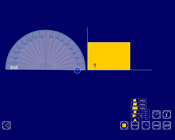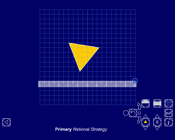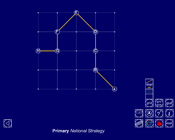Example review questions
Use a calculator to solve the following problems.
- Nicola has £50. She buys three CDs at £12.75 each and a DVD at £9.65. How much money does she have left?
- Nasreen made some fruit punch. She poured 1.5 litres of orange juice, 1350 ml of pineapple juice and 780 ml of mango juice into a large bowl. How much fruit punch did she make?
- A full box holds 180 pins. How many boxes can be filled from 100 000 pins?
- A rope is 12 metres long. How many lengths of 85 cm can I cut from it?
- A bus holds 52 people. How many buses are needed for 327 people?
Consolidation and practice
These resources are to support children in guided or independent work.
Calculating angles

This interactive teaching program (ITP) is an ICT-based tool to support the exploration of angles. Calculating angles ITP allows the child or teacher to represent single or multiple shapes rotated around a central point in one, two or four quadrants. The size of angles can be estimated or calculated and confirmed using the on-screen protractor or reveal function.
Polygon

This interactive teaching program (ITP) is an ICT-based tool to support the exploration of shape, space and measure. Polygon ITP allows the child or teacher to represent regular polygons with three to ten sides. The ITP can then be used to explore the properties of regular and irregular shapes by dragging vertices and creating additional vertices. The ITP includes an on-screen protractor and ruler.
Fixing points

This interactive teaching program (ITP) is an ICT-based tool to support the exploration of shape and space. Fixing points ITP allows the child or teacher to create one or more shapes by connecting a number of vertices on a grid. Angles can be estimated and measured, and the effect of moving different vertices can be explored.
Opportunities to use and apply
Possible contexts include:
- using a calculator when making use of real data gathered in research and experiments, in subjects such as geography, history and science.
- problems or situations where children need to round up and down depending on the context, e.g. A football club has £240 for footballs. Each ball costs £52. How many footballs can they buy?
- games and challenges, e.g. How can I change 45.97 to 9, using exactly ten individual key presses on my calculator?
Confirming learning
Ask probing questions such as:
- My calculator shows an answer of 3.5. If the question was about money, how would you interpret the answer? What if the question was about weight?
- Give me an example of a question where you would round the answer on the calculator display up. Now give me one where you would round the answer down.
- How could I change 4003.725 on my calculator to 7? Try to do it with the fewest possible key presses.
 Calculating
Calculating


